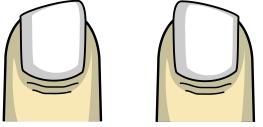It’s a technique that many have grappled with. Some succeed, using their nails to create harmonies that entrance and mystify those who hear them. Some swear against playing without first trimming their nails, claiming the level of difficulty is too high or that the sound isn’t to their liking. Some simply sit and wonder – never able to find out how to play guitar with long nails.
Why Play Guitar with Long Nails?

Some prefer to keep the fingernails on their picking hand long for a number of reasons. First off, for beginners who might not be aware – we’re talking about the fingernails on your strumming/picking hand, not your fretting hand. For the average, right-handed guitarist, this will be your right hand.
Having long fingernails on your fretting hand will provide absolutely no benefit and is avoided – some musicians claim this makes playing guitar effectively impossible. However, there are several benefits to maintaining the length of the nails on your picking hand.
Benefits of Playing Guitar with Long Nails
- Some find it easier to play this way. Keeping your nails long allows for more power in the pluck of your string.
- Some find the sound of a string plucked with a fingernail to be much nicer for their play style. The alternative is to pluck the string with the tip of your finger, which can somewhat muffle the sound.
- Some people find the skin on their fingertips gets sore – keeping untrimmed nails can limit that pain.
- You can become faster, play louder, and be more dextrous with long nails.
Benefits of Playing Guitar with Short Nails
- If you play guitar with long nails, they will undoubtedly chip as they strike the strings repeatedly. This can create a need for expensive, time consuming maintenance.
- Short nails provide more sensitivity when playing, and some find a more emotional connection to their music since they’re actually touching the strings.
Ultimately, it’s personal preference. Some people prefer to play guitar with long nails, and others don’t. If you’re just starting out, it’s recommended that you learn how to play guitar with long nails and without, so you can decide which style suits your playing best.
Maintenance & Tips on How Play Guitar with Long Nails

Those who play guitar with long nails will notice that their fingernails take damage – sometimes, quite quickly. The force of striking a string repeatedly with the strength of a guitar pick does some serious wear-and-tear on your nails. Fortunately, there are ways to prevent this.
- You’ll want to make sure that you shape your fingernails into something that resembles a pick. The shape will differ from person to person, and depends on their personal preference.
- You can get a personal manicure kit, which allows you to trim and shape your nails on-the-go.
- Consider getting acrylic nails. They are essentially lacquered – first, they’re coated with a primer, then brushed with a powder that strengthens the nails. They will be extremely hard to chip or damage after they’ve been lacquered!
- Using acrylic nails will require that you get a much stronger nail file than average. Many guitarists recommend a diamond file, but that could be expensive for the average guitar player.
Tips on Fingernail Length
Many guitarists have different lengths of fingernails. Again, this is a matter of personal preference – though, there are some guidelines to follow.
- Hold your hand out, palm facing you.
- Your fingernails should extend no longer than 2 millimeters.
- It can be hard to play guitar with long nails if they extend beyond 2mm. Excessive length makes fingerpicking quite a chore. It becomes easy to drag your nail along the string, creating unintended sounds. It also becomes easy to play strings you didn’t intend to.
- You may notice untrained or inexperienced people playing guitar with extremely long nails. While it may seem easier – and, indeed, a few folks may have mastered this technique – it is generally regarded as easier and safer to play guitar with nails no longer than 2mm.
Tips on Fingernail Shape
Fingernail shape is another aspect that can’t be overlooked. Maintaining the ideal shape can be a bit difficult, but here are some guidelines to follow.
Rounded Fingernails:
 These are most common among classical guitar players. Rounded fingernails are versatile and work well with all sorts of different types of fingerpicking. They’re easy to use and produce reliable, balanced sounds. Rounded nails are good for beginners or for those who are just experimenting with long nails for guitar playing.
These are most common among classical guitar players. Rounded fingernails are versatile and work well with all sorts of different types of fingerpicking. They’re easy to use and produce reliable, balanced sounds. Rounded nails are good for beginners or for those who are just experimenting with long nails for guitar playing.
To do this, file the tip of the nail into a half-circle. Make sure you file off any edge or point, so it looks even and symmetrical on both sides.
Sloped Fingernails:

These are also very commonly seen among classical guitar layers. Sloped nails offer minimal resistance when striking a string, which creates a warm and inviting tone.
To make sloped nails, just file them so they create a slope! It can slope either right or left, but make sure the slope is straight and even.
Pointed Fingernails:

Pointed fingernails are much less common than the other types, but some rely on them. They produce a very strong, remarkable, bright sound when they strike a string.
Filing pointed nails requires you to evenly file each side so they rise to meet each other. How in the center. This should create a symmetrical shape that makes your fingernails feel like they were each their own guitar pick!
Conclusions
If you didn’t know how to play guitar with long nails, now you’ve got the basic information. Use this information to shape your nails in a manner that suits your own style and techniques – you’ll probably find that you’ll be producing much nicer music within hours.
Classical guitarists have used long nails in their playing styles for years. There’s a reason for this – playing guitar with long nails really amplifies the sound and power behind your notes. Give it a try!

